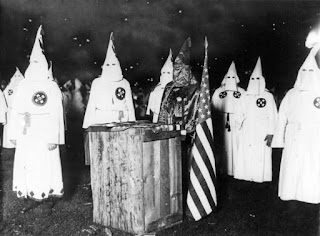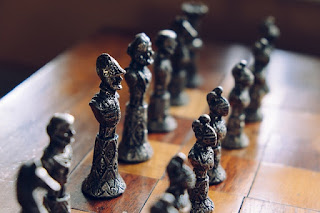A secret terrorist organization, the Ku Klux Klan led underground resistance against the civil rights and political power of newly freed slaves during the Reconstruction period after the American Civil War. The Klan's goal was to reestablish the dominance of the prewar plantation aristocracy. It was revived in an altered form in the 20th century.
Organized in 1866 by Confederate veterans as a social club in Pulaski, Tenn., the Ku Klux Klan was restructured along political and racial lines a year later in Nashville, Tenn. Sometimes called the Invisible Empire of the South, the KKK, or the Klan, it was presided over by a grand wizard and a descending hierarchy of grand dragons, grand titans, and grand cyclopses. They took the name of the organization from the Greek word kyklos, meaning "circle," and the English word clan. Dressed in robes and hoods designed to frighten superstitious victims and to prevent identification by Federal troops, Klansmen whipped and killed freed slaves in nighttime raids. With intimidation and threats, Klansmen drove blacks and their white sympathizers out of their communities, destroying their crops and burning their houses and barns.
Because of an increase in the number of kidnappings and murders, the grand wizard of the Klan ordered it disbanded in 1869, but local groups remained active. The rest of the nation reacted strongly to the increased violence in the South, and Congress passed the Force Act in 1870 and the Ku Klux Klan Act in 1871, authorizing the president to suspend the writ of habeas corpus, suppress disturbances by force, and impose heavy penalties on terrorist organizations. Resulting federal prosecution of Klan members, however, created widespread Southern sympathy in their behalf. As Southern political power gradually reverted to traditional white Democratic control during the 1870s, the need for anti-Republican, anti-black organizations to remain secret decreased.
Image Source pixabay
The Klan was reorganized in 1915 near Atlanta, Ga., and its popularity peaked in the 1920s when its membership exceeded 4 million nationally, with strong organizations in the Midwest as well as in the South. The new Klan began to persecute Roman Catholics, Jews, foreigners, Communists, and organized labor. Stressing white Protestant supremacy, the Klan enjoyed a spurt of growth in 1928 as a reaction to the Democrats' nomination for president of Alfred E. Smith, a Roman Catholic. During the Great Depression of the 1930s, the Klan's membership dropped dramatically, and after a federal suit for income tax delinquency in 1944, the Klan went bankrupt. However, in the mid-1960s, as civil rights workers attempted to promote compliance with the Civil Rights Act of 1964, the Klan briefly revived once again. It faded rapidly after President Lyndon Johnson denounced the organization in 1965.
The Klan was reorganized in 1915 near Atlanta, Ga., and its popularity peaked in the 1920s when its membership exceeded 4 million nationally, with strong organizations in the Midwest as well as in the South. The new Klan began to persecute Roman Catholics, Jews, foreigners, Communists, and organized labor. Stressing white Protestant supremacy, the Klan enjoyed a spurt of growth in 1928 as a reaction to the Democrats' nomination for president of Alfred E. Smith, a Roman Catholic. During the Great Depression of the 1930s, the Klan's membership dropped dramatically, and after a federal suit for income tax delinquency in 1944, the Klan went bankrupt. However, in the mid-1960s, as civil rights workers attempted to promote compliance with the Civil Rights Act of 1964, the Klan briefly revived once again. It faded rapidly after President Lyndon Johnson denounced the organization in 1965.
The Klan revived with renewed vigor in the late 1970s. It fragmented into several separate and competing groups, some of which allied themselves with neo-Nazi and other right-wing extremist groups. By the early 1990s, after being prosecuted for illegal activities, the Klan was estimated to have between 6,000 and 10,000 active members, mostly in the deep South.




Comments
Post a Comment